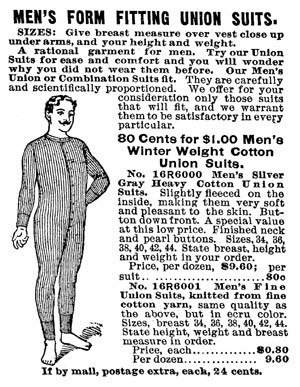
Fashion historians may remember the original “union suit” as being a butt of jokes. It looked normal from the front — like long johns, but the back had a butt flap. One of the funniest scenes from a mid-century western shows a guy armed with a shotgun, running out of a shack in his union suit, his undone butt-flap bouncing up and down (fortunately, the camera showed him from the side.) Now, this time-honored underwear is enjoying a kind of renaissance with websites such as Amazon featuring a bunch of versions.

The union suit was one of the first examples of “adaptive” clothing because it was easy to relieve oneself. With today’s adaptive clothing, each piece presents with a host of easy-to-fasten trousers, blouses, shirts, and other clothing. If you’ve ever tried to do up a zip or button a shirt one-handed, put on a pair of jeans while seated, you’ll find these garments a minor miracle. Men’s and women’s tops, pants, jackets, and sweaters feature magnetic closures, large snaps that make it easy for arthritic hands, and zippers in strategic locations to facilitate toileting.
Caregivers of dementia patients find this a blessing because it eliminates the need to pull down wet pajamas at night to change a diaper. While some caregivers find nightshirts convenient, adaptive clothing provides more variety. The website Britannica offers that magnetic zippers in clothing make it easier to do up with one hand. Tying shoelaces are a special challenge for dementia patients; one sneaker on the market utilizes a hinge design; the wearer steps into the shoe and the hinge opens, holding the shoe in place.
In 2016, CEO and founder of Runway of Dreams partnered with clothing designer Tommy Hilfiger, launching the first-ever mainstream adaptive clothing line for kids, and it’s now became Tommy Hilfiger Adaptive, available for both kids and adults. More companies such as Joe and Bella, Target, Zappos, Kohl’s, and Nike have entered the adaptive market.
As Alzheimer’s and dementia patients go into decline, they forget how to button a shirt or belt and how to don a pair of trousers; then it’s up to the caregiver to dress them. I know from experience that it can add ½ hour to a morning roster of chores.
Manufacturers of adaptive clothing try to add style to their clothing; some, such as sweaters, are unisex, but most are distinctly crafted for a man and woman, handsome and easy to use. Some caregivers like me want their loved ones to continue, if possible, to dress themselves. It’s good for eye-hand coordination, maintains some agility for the brain, and it provides the patient with a sense of control and accomplishment.
We want to hear from you, so feel free to share tips, ideas, and resources for seniors and caregivers with Grannybooster. Email me, Maris Somerville, at [email protected]


Leave a Reply